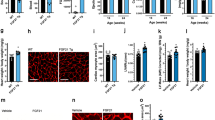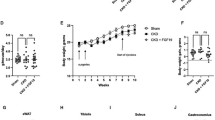Abstract
The endocrine-derived hormone fibroblast growth factor (FGF) 19 has recently emerged as a potential target for treating metabolic disease1. Given that skeletal muscle is a key metabolic organ, we explored the role of FGF19 in that tissue. Here we report a novel function of FGF19 in regulating skeletal muscle mass through enlargement of muscle fiber size, and in protecting muscle from atrophy. Treatment with FGF19 causes skeletal muscle hypertrophy in mice, while physiological and pharmacological doses of FGF19 substantially increase the size of human myotubes in vitro. These effects were not elicited by FGF21, a closely related endocrine FGF member. Both in vitro and in vivo, FGF19 stimulates the phosphorylation of the extracellular-signal-regulated protein kinase 1/2 (ERK1/2) and the ribosomal protein S6 kinase (S6K1), an mTOR-dependent master regulator of muscle cell growth. Moreover, mice with a skeletal-muscle-specific genetic deficiency of β-Klotho (KLB), an obligate co-receptor for FGF15/19 (refs. 2,3), were unresponsive to the hypertrophic effect of FGF19. Finally, in mice, FGF19 ameliorates skeletal muscle atrophy induced by glucocorticoid treatment or obesity, as well as sarcopenia. Taken together, these findings provide evidence that the enterokine FGF19 is a novel factor in the regulation of skeletal muscle mass, and that it has therapeutic potential for the treatment of muscle wasting.
This is a preview of subscription content, access via your institution
Access options
Access Nature and 54 other Nature Portfolio journals
Get Nature+, our best-value online-access subscription
$29.99 / 30 days
cancel any time
Subscribe to this journal
Receive 12 print issues and online access
$209.00 per year
only $17.42 per issue
Buy this article
- Purchase on Springer Link
- Instant access to full article PDF
Prices may be subject to local taxes which are calculated during checkout




Similar content being viewed by others
References
Degirolamo, C., Sabbà, C. & Moschetta, A. Therapeutic potential of the endocrine fibroblast growth factors FGF19, FGF21 and FGF23. Nat. Rev. Drug Discov. 15, 51–69 (2016).
Lin, B.C., Wang, M., Blackmore, C. & Desnoyers, L.R. Liver-specific activities of FGF19 require Klotho beta. J. Biol. Chem. 282, 27277–27284 (2007).
Owen, B.M., Mangelsdorf, D.J. & Kliewer, S.A. Tissue-specific actions of the metabolic hormones FGF15/19 and FGF21. Trends Endocrinol. Metab. 26, 22–29 (2015).
Ornitz, D.M. & Itoh, N. The fibroblast growth factor signaling pathway. Wiley Interdiscip. Rev. Dev. Biol. 4, 215–266 (2015).
Kir, S. et al. FGF19 as a postprandial, insulin-independent activator of hepatic protein and glycogen synthesis. Science 331, 1621–1624 (2011).
Inagaki, T. et al. Fibroblast growth factor 15 functions as an enterohepatic signal to regulate bile acid homeostasis. Cell Metab. 2, 217–225 (2005).
Adams, A.C. et al. The breadth of FGF21's metabolic actions are governed by FGFR1 in adipose tissue. Mol. Metab. 2, 31–37 (2013).
Fu, L. et al. Fibroblast growth factor 19 increases metabolic rate and reverses dietary and leptin-deficient diabetes. Endocrinology 145, 2594–2603 (2004).
Kurosu, H. et al. Tissue-specific expression of βKlotho and fibroblast growth factor (FGF) receptor isoforms determines metabolic activity of FGF19 and FGF21. J. Biol. Chem. 282, 26687–26695 (2007).
Tomlinson, E. et al. Transgenic mice expressing human fibroblast growth factor-19 display increased metabolic rate and decreased adiposity. Endocrinology 143, 1741–1747 (2002).
Morton, G.J. et al. FGF19 action in the brain induces insulin-independent glucose lowering. J. Clin. Invest. 123, 4799–4808 (2013).
Miyata, M., Sakaida, Y., Matsuzawa, H., Yoshinari, K. & Yamazoe, Y. Fibroblast growth factor 19 treatment ameliorates disruption of hepatic lipid metabolism in farnesoid X receptor (Fxr)-null mice. Biol. Pharm. Bull. 34, 1885–1889 (2011).
Baskin, K.K., Winders, B.R. & Olson, E.N. Muscle as a “mediator” of systemic metabolism. Cell Metab. 21, 237–248 (2015).
Potthoff, M.J. et al. FGF15/19 regulates hepatic glucose metabolism by inhibiting the CREB-PGC-1α pathway. Cell Metab. 13, 729–738 (2011).
Rowe, R.W. & Goldspink, G. Muscle fibre growth in five different muscles in both sexes of mice. J. Anat. 104, 519–530 (1969).
Mashili, F.L. et al. Direct effects of FGF21 on glucose uptake in human skeletal muscle: implications for type 2 diabetes and obesity. Diabetes Metab. Res. Rev. 27, 286–297 (2011).
Bodine, S.C. et al. Akt/mTOR pathway is a crucial regulator of skeletal muscle hypertrophy and can prevent muscle atrophy in vivo. Nat. Cell Biol. 3, 1014–1019 (2001).
Ohanna, M. et al. Atrophy of S6K1−/− skeletal muscle cells reveals distinct mTOR effectors for cell cycle and size control. Nat. Cell Biol. 7, 286–294 (2005).
Roux, P.P., Ballif, B.A., Anjum, R., Gygi, S.P. & Blenis, J. Tumor-promoting phorbol esters and activated Ras inactivate the tuberous sclerosis tumor suppressor complex via p90 ribosomal S6 kinase. Proc. Natl. Acad. Sci. USA 101, 13489–13494 (2004).
Nicole, S. et al. Intact satellite cells lead to remarkable protection against Smn gene defect in differentiated skeletal muscle. J. Cell Biol. 161, 571–582 (2003).
Anker, S.D. et al. Wasting as independent risk factor for mortality in chronic heart failure. Lancet 349, 1050–1053 (1997).
Kim, T.N. et al. Prevalence and determinant factors of sarcopenia in patients with type 2 diabetes: the Korean Sarcopenic Obesity Study (KSOS). Diabetes Care 33, 1497–1499 (2010).
Wada, S. et al. Translational suppression of atrophic regulators by microRNA-23a integrates resistance to skeletal muscle atrophy. J. Biol. Chem. 286, 38456–38465 (2011).
Gilson, H. et al. Myostatin gene deletion prevents glucocorticoid-induced muscle atrophy. Endocrinology 148, 452–460 (2007).
Kammoun, M., Cassar-Malek, I., Meunier, B. & Picard, B. A simplified immunohistochemical classification of skeletal muscle fibres in mouse. Eur. J. Histochem. 58, 2254 (2014).
Sawey, E.T. et al. Identification of a therapeutic strategy targeting amplified FGF19 in liver cancer by oncogenomic screening. Cancer Cell 19, 347–358 (2011).
Zhou, M. et al. Separating tumorigenicity from bile acid regulatory activity for endocrine hormone FGF19. Cancer Res. 74, 3306–3316 (2014).
Ding, X. et al. βKlotho is required for fibroblast growth factor 21 effects on growth and metabolism. Cell Metab. 16, 387–393 (2012).
Miniou, P. et al. Gene targeting restricted to mouse striated muscle lineage. Nucleic Acids Res. 27, e27 (1999).
Pasut, A., Jones, A.E. & Rudnicki, M.A. Isolation and culture of individual myofibers and their satellite cells from adult skeletal muscle. J. Vis. Exp. 73, e50074 (2013).
Cozzone, D. et al. Activation of liver X receptors promotes lipid accumulation but does not alter insulin action in human skeletal muscle cells. Diabetologia 49, 990–999 (2006).
Rieusset, J. et al. Suppressor of cytokine signaling 3 expression and insulin resistance in skeletal muscle of obese and type 2 diabetic patients. Diabetes 53, 2232–2241 (2004).
Dessalle, K. et al. SREBP-1 transcription factors regulate skeletal muscle cell size by controlling protein synthesis through myogenic regulatory factors. PLoS One 7, e50878 (2012).
De Larichaudy, J. et al. TNF-α- and tumor-induced skeletal muscle atrophy involves sphingolipid metabolism. Skelet. Muscle 2, 2 (2012).
Ruzzin, J. et al. Persistent organic pollutant exposure leads to insulin resistance syndrome. Environ. Health Perspect. 118, 465–471 (2010).
Bravard, A. et al. FTO is increased in muscle during type 2 diabetes, and its overexpression in myotubes alters insulin signaling, enhances lipogenesis and ROS production, and induces mitochondrial dysfunction. Diabetes 60, 258–268 (2011).
Acknowledgements
We thank D.J. Mangelsdorf and S.A. Kliewer (University of Texas Southwestern Medical Center, Dallas, Texas, USA) for providing the Klb+/−, Klb−/− and Klbfl/fl mice and J. Melki (Université Paris Sud, Paris, France) for providing the HSA-Cre mice. We thank the Plateau de Biologie Expérimentale de la Souris (Ecole Normale Supérieure, Lyon, France) for excellent animal care and breeding. This work was supported by the Research Council of Norway (projects #230394 and #228135) and from INSERM and INRA research funds. B.B. is supported by a grant from the Environmental Exposures and Health Outcomes programme from the Research Council of Norway. J. Ruzzin is supported by the FRIPRO Young Research Talents programme from the Research Council of Norway.
Author information
Authors and Affiliations
Contributions
D.F., E.L., H.V. and J. Ruzzin conceived and designed the study. B.B., E.M., M.C., S.C., A.V.-M., C.D., N.B., P.-A.M., S.P., A.-C.D., J. Rieusset and J. Ruzzin performed the experiments. B.B., H.V. and J. Ruzzin wrote the manuscript, with contributions from all the other authors.
Corresponding author
Ethics declarations
Competing interests
A patent covering the hypertrophic effect of FGF15/19 in muscle has been filed.
Supplementary information
Supplementary Text and Figures
Supplementary Figures 1–10 and Supplementary Tables 1–2 (PDF 11542 kb)
Rights and permissions
About this article
Cite this article
Benoit, B., Meugnier, E., Castelli, M. et al. Fibroblast growth factor 19 regulates skeletal muscle mass and ameliorates muscle wasting in mice. Nat Med 23, 990–996 (2017). https://doi.org/10.1038/nm.4363
Received:
Accepted:
Published:
Issue Date:
DOI: https://doi.org/10.1038/nm.4363
This article is cited by
-
Lactate ameliorates palmitate-induced impairment of differentiative capacity in C2C12 cells through the activation of voltage-gated calcium channels
Journal of Physiology and Biochemistry (2024)
-
Development of muscle weakness in a mouse model of critical illness: does fibroblast growth factor 21 play a role?
Skeletal Muscle (2023)
-
FGF19 increases mitochondrial biogenesis and fusion in chondrocytes via the AMPKα-p38/MAPK pathway
Cell Communication and Signaling (2023)
-
Exploring the correlation between serum fibroblast growth factor-21 levels and Sarcopenia: a systematic review and meta-analysis
BMC Musculoskeletal Disorders (2023)
-
SGLT2 inhibitor empagliflozin promotes revascularization in diabetic mouse hindlimb ischemia by inhibiting ferroptosis
Acta Pharmacologica Sinica (2023)



